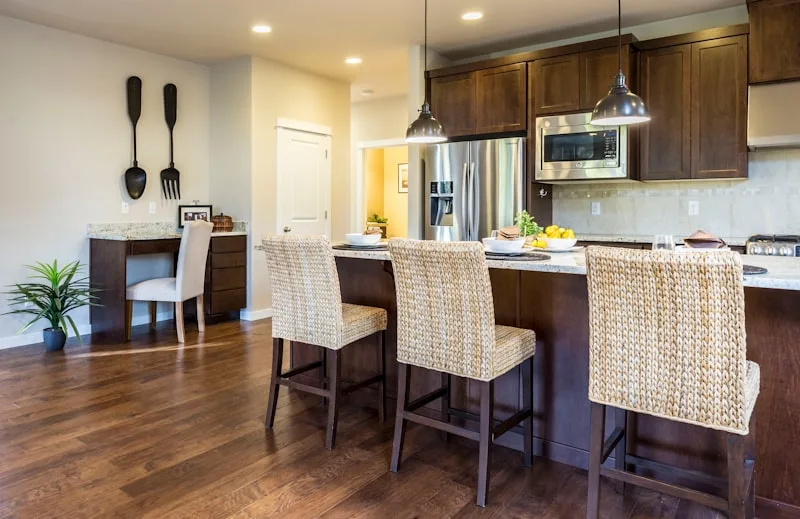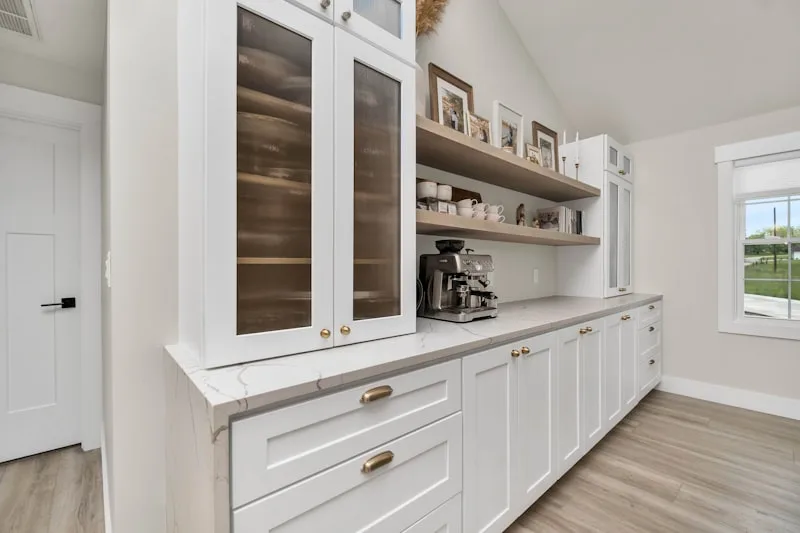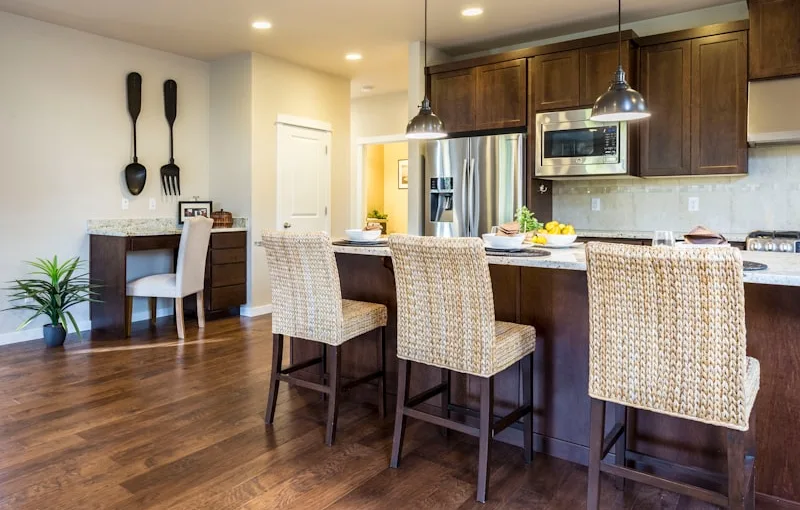Most standard kitchen cabinets are designed to hold a decent amount of weight, but there are a few things to consider. First off, think about the materials. If your cabinets are made of solid wood, they’re likely to be sturdier than those made from particleboard. It’s like comparing a rock to a sponge—one can take a beating, while the other might crumble under pressure.
Next, consider the shelf design. Many cabinets come with adjustable shelves, which can be a game-changer. By placing heavier items on lower shelves, you’re not only making it easier to access your canned goods but also reducing the risk of overloading the upper shelves. It’s all about balance, much like a seesaw—too much weight on one side, and things can tip over.
Also, don’t forget about the cabinet’s mounting. If they’re securely anchored to the wall, they’ll be better equipped to handle the weight. Think of it as a strong foundation for a house; without it, everything could come crashing down.
Can Your Kitchen Cabinets Handle the Weight? A Deep Dive into Canned Goods Storage
First off, let’s talk about the weight of those little metal cans. A standard can of soup weighs about 15 ounces, and if you’ve got a dozen of them stacked up, that’s over 10 pounds! Now, imagine cramming in a few more cans of veggies, fruits, and sauces. Before you know it, you’re pushing your cabinets to their limits. It’s like trying to fit an elephant into a Volkswagen—something’s gotta give!

Now, not all cabinets are created equal. If you’ve got solid wood cabinets, they’re generally more robust and can handle a heavier load. But if your cabinets are made of particleboard or MDF, they might buckle under pressure. Think of it like a sturdy bridge versus a flimsy footbridge; one can support a lot more weight than the other.
Heavy Lifting: Are Standard Kitchen Cabinets Up to the Task of Storing Canned Goods?
Imagine your kitchen cabinets as the unsung heroes of your culinary kingdom. They’re designed to hold everything from your favorite spices to your grandma’s china, but when it comes to canned goods, they might be feeling a bit overwhelmed. Standard cabinets typically have a weight limit, and those cans can add up quickly. A single can of soup might not weigh much, but stack a dozen of them, and you’re looking at a mini workout for your cabinets!
Now, think about the layout of your kitchen. If you’re cramming all those cans into a single shelf, you might be setting yourself up for a disaster. Overloading can lead to sagging shelves or, worse, a complete collapse. It’s like trying to fit a square peg in a round hole—something’s gotta give!
So, what’s the solution? Consider using pull-out shelves or dedicated pantry cabinets designed specifically for heavy items. These options not only make it easier to access your canned goods but also distribute the weight more evenly. Plus, who doesn’t love a well-organized pantry that looks like it belongs in a magazine?
In the end, while standard kitchen cabinets can handle some canned goods, it’s all about smart storage solutions. After all, you want your kitchen to be functional and fabulous, right? So, let’s keep those cabinets happy and your canned goods safe!
Canned Goods Conundrum: The Truth About Kitchen Cabinet Durability
Picture this: you’ve just bought a dozen cans of your favorite soup, and you’re excited to tuck them away in your cabinets. But wait! Those cabinets are not just a simple storage solution; they’re a crucial part of your kitchen’s structure. Overloading them with heavy items can lead to sagging shelves and, eventually, a cabinet collapse. It’s like trying to stack too many books on a flimsy shelf—eventually, something’s gotta give!
Now, let’s talk materials. If your cabinets are made of solid wood, they might handle the weight better than particleboard or MDF. Think of solid wood as the sturdy friend who can carry all the groceries in one trip, while particleboard is more like that friend who needs a break halfway through. So, if you’re a canned goods enthusiast, consider the material of your cabinets before you start stacking.
And what about the layout? Organizing your canned goods wisely can make a world of difference. Place the heavier cans on lower shelves where they’re easier to access and won’t strain the cabinet structure. It’s like putting the big weights on the bottom rack at the gym—balance is key!
From Soup to Nuts: Assessing the Load-Bearing Capacity of Your Kitchen Cabinets

First off, consider the materials. Solid wood cabinets are like the heavyweight champions of the kitchen—they can take a beating and still stand tall. On the other hand, particleboard or MDF might be more budget-friendly, but they can buckle under pressure. Imagine trying to stack a mountain of books on a flimsy shelf; it’s just not going to end well!
Next, think about the design. Are your cabinets mounted directly to the wall or are they freestanding? Wall-mounted cabinets often have a different load capacity because they rely on wall studs for support. It’s like hanging a heavy painting; you wouldn’t just slap it on the wall without checking if it’s anchored properly, right?
Now, let’s talk about distribution. Just like balancing a seesaw, evenly distributing weight is crucial. If you cram all your heavy pots on one side, you might find your cabinet sagging like an old sofa. Instead, spread the load out—think of it as giving your cabinets a workout routine that keeps them fit and functional.
Lastly, don’t forget about the hardware. Hinges and brackets are the unsung heroes of your cabinets. High-quality hardware can make a world of difference, ensuring that your cabinets can handle whatever you throw at them. So, next time you’re loading up your cabinets, remember: it’s all about strength, balance, and the right support!
Storage Solutions: How to Safely Store Heavy Canned Goods in Regular Cabinets
First off, think about the layout. Place the heaviest cans on the bottom shelves. It’s like building a solid foundation for a house; you wouldn’t put the roof on before the walls, would you? This not only prevents your cabinets from tipping over but also makes it easier to grab what you need without straining your back.
Next, consider using storage bins or baskets. These are like the superheroes of organization! They can help you group similar items together, making it easier to find what you’re looking for. Plus, they add a touch of style to your cabinets. Just imagine opening your cabinet doors to a neat, organized display instead of a chaotic mess.
Don’t forget about the importance of accessibility. If you have a can that you use often, keep it at eye level. It’s like having your favorite book on the top shelf; you want it within reach! And if you’re stacking cans, make sure to alternate the direction they face. This way, you can easily see what you have without playing a game of “guess what’s in the back.”
Lastly, always check the expiration dates. It’s like a little reminder to keep your pantry fresh and your meals delicious. By following these simple tips, you can turn your regular cabinets into a safe haven for your heavy canned goods, making your kitchen both functional and fabulous!
Frequently Asked Questions
Can regular kitchen cabinets hold heavy canned goods?
Regular kitchen cabinets are typically designed to hold a moderate amount of weight, but their ability to support heavy canned goods depends on the cabinet’s construction and materials. It’s advisable to check the weight capacity specified by the manufacturer and distribute the weight evenly to prevent damage or sagging.
What weight capacity do standard kitchen cabinets have?
Standard kitchen cabinets typically have a weight capacity of 150 to 200 pounds per shelf. This capacity can vary based on the cabinet’s construction, materials, and design. It’s important to distribute weight evenly and avoid overloading shelves to ensure safety and longevity.
How to reinforce kitchen cabinets for heavy storage?
To reinforce kitchen cabinets for heavy storage, consider adding additional support brackets or L-brackets to the corners and sides. Use plywood or particle board as a backing to distribute weight evenly. Ensure that the cabinets are securely anchored to the wall and consider using heavier-duty hinges and drawer slides for added strength. Regularly check for any signs of wear or sagging and make adjustments as needed.
Are there specific cabinets designed for heavy items?
Yes, there are cabinets specifically designed to support heavy items. These cabinets are constructed with reinforced materials and sturdy shelving systems to ensure stability and safety. They often feature adjustable shelves, heavy-duty hinges, and locking mechanisms to secure contents. When selecting a cabinet for heavy items, consider the weight capacity, dimensions, and material to ensure it meets your storage needs.
What are the best practices for storing canned goods in cabinets?
To ensure the longevity and safety of canned goods, store them in a cool, dry place away from direct sunlight. Organize cans by type and expiration date, placing older items at the front for easy access. Avoid stacking cans too high to prevent crushing and check for any signs of damage or rust before use. Maintain a consistent temperature and humidity level to preserve the quality of the food.
